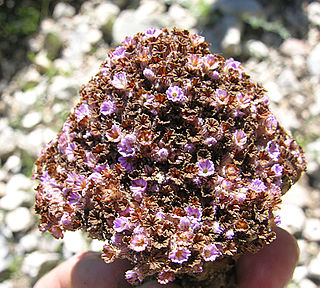
The Rubiaceae are a family of flowering plants, commonly known as the coffee, madder, or bedstraw family. It consists of terrestrial trees, shrubs, lianas, or herbs that are recognizable by simple, opposite leaves with interpetiolar stipules and sympetalous actinomorphic flowers. The family contains about 13,500 species in about 620 genera, which makes it the fourth-largest angiosperm family. Rubiaceae has a cosmopolitan distribution; however, the largest species diversity is concentrated in the tropics and subtropics. Economically important genera include Coffea, the source of coffee, Cinchona, the source of the antimalarial alkaloid quinine, ornamental cultivars, and historically some dye plants.

Brachionidium is a genus of about 72 species of orchids, found throughout much of tropical America. The generic name comes from Greek and refers to the protrusions on the stigma.

Palicourea is a genus of flowering plants in the family Rubiaceae. It contains 694 species, which range from shrubs to small trees, and is distributed throughout the New World tropics.
Ihsan Ali Al-Shehbaz is an American botanist who works as adjunct professor at University of Missouri-St. Louis and Senior Curator at Missouri Botanical Garden. Al-Shehbaz's primary area of interest is Brassicaceae and The Durango Herald called him "a world expert on taxonomy of the family". A 2008 publication of the United States Fish and Wildlife Service called him "the world's authority on species in the genus Lesquerella". The author abbreviation "Al-Shehbaz" is attached to the numerous botanical taxa he has identified.
Oplismenopsis is a genus of South American plants in the grass family. The only known species is Oplismenopsis najada, native to southern Brazil, Uruguay, and northeastern Argentina.

Veronica elliptica, synonym Hebe elliptica, is a plant of the family Plantaginaceae. It is native to New Zealand, south Argentina, south Chile and the Falkland Islands. It is an evergreen, bushy shrub of 1 m or more in height, with green, oval leaves, 2–4 cm long. Flowers are white to pale mauve.

Kadua is a genus of flowering plants in the family Rubiaceae. It comprises 29 species, all restricted to Polynesia. Twenty-two of these are endemic to the Hawaiian Islands. Some of the species are common at high elevation. Others are single-island endemics or very rare, and a few are probably extinct. Kadua affinis is widely distributed in Hawaii and is polymorphic. The type species for the genus is Kadua acuminata.

Hippeastrum aulicum, the Lily of the Palace, is a bulbous perennial, in the family Amaryllidaceae, native to the Atlantic Forest and Cerrado ecoregions from Brazil to Paraguay, in South America.
Lois Brako is an American botanist, mycologist and explorer. She has conducted botanical expeditions in Peru.

Hippeastrum miniatum is a flowering perennial herbaceous bulbous plant, in the family Amaryllidaceae, native to Peru.

Hippeastrum papilio is a flowering perennial herbaceous bulbous plant, in the family Amaryllidaceae, native to southern Brasil.

Hippeastrum psittacinum is a flowering perennial herbaceous bulbous plant, in the family Amaryllidaceae, native to Brazil.

Heterostachys is a genus of flowering plants in the plant family Amaranthaceae. The two species are shrubby halophytes native to South America and Central America.

Gunnera magellanica is a perennial rhizomatous dioeceous herb native to Chile, Argentina and the Falkland Islands, and Andean areas of Peru, Ecuador. In the southern part of its range it grows in damper parts of the Magellanic subpolar forests and Valdivian temperate forests, and shrub formations on Tierra del Fuego, with an altitudinal range from sea level to 1500m.

Hippeastrum striatum, the striped Barbados lily, a flowering perennial herbaceous bulbous plant, in the family Amaryllidaceae, native to the southern and eastern regions of Brazil.
Hypericum aciculare is a shrub in the genus Hypericum, in the section Brathys. It is an accepted name according to The Plant List and Tropicos.

Philodendron appendiculatum, also known as güembé, is a perennial species in the genus Philodendron, belonging to the family Araceae. It lives in the jungles, wetlands, and moist forests of South America.
Palicoureeae is a tribe of flowering plants in the family Rubiaceae and contains about 817 species in 11 genera. Its representatives are found in the tropics and subtropics.

Allenrolfea is a genus of shrubs in the family Amaranthaceae. The genus was named for the English botanist Robert Allen Rolfe. There are three species, ranging from North America to South America.

Lennoa is a monotypic genus of flowering plants belonging to the family Boraginaceae. It only contains one known species, Lennoa madreporoidesLex. It is within the subfamily of Lennoaceae.















